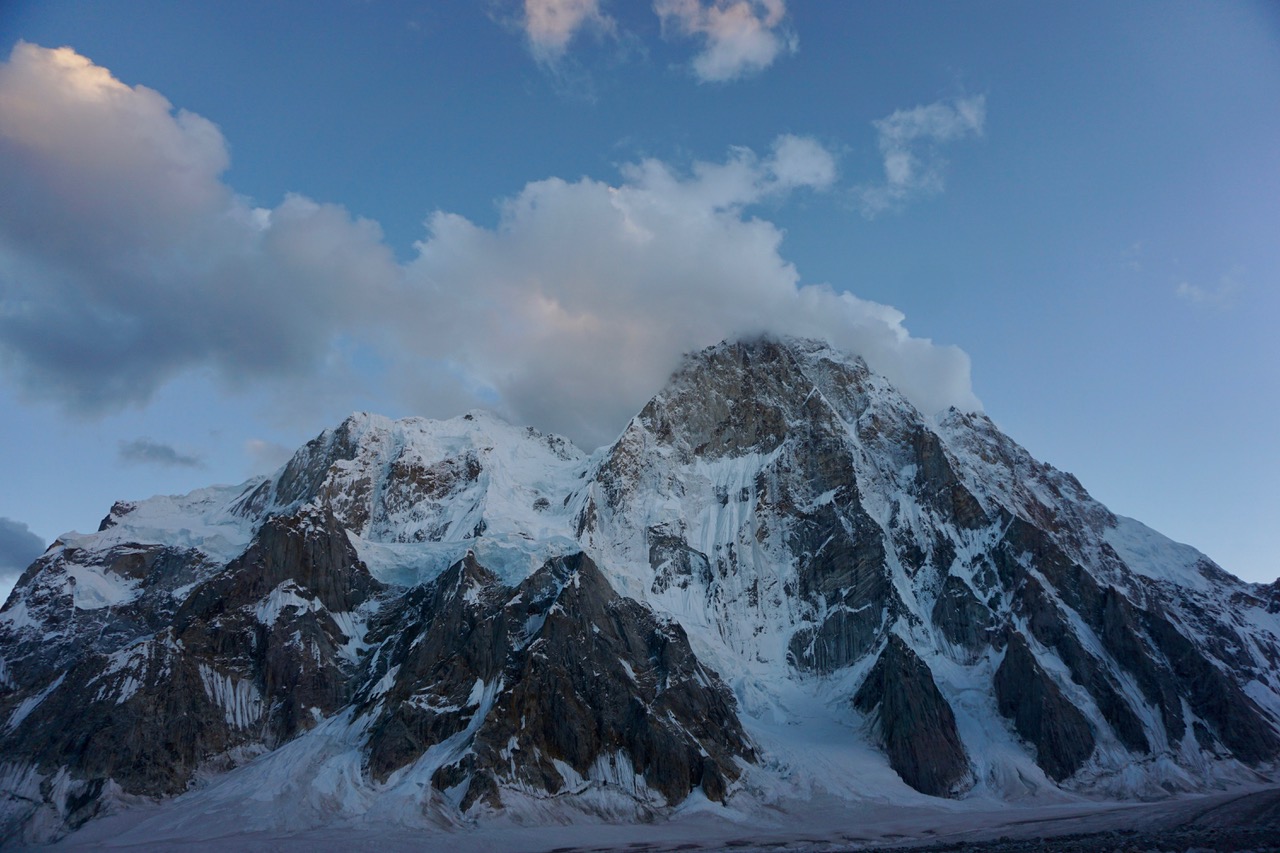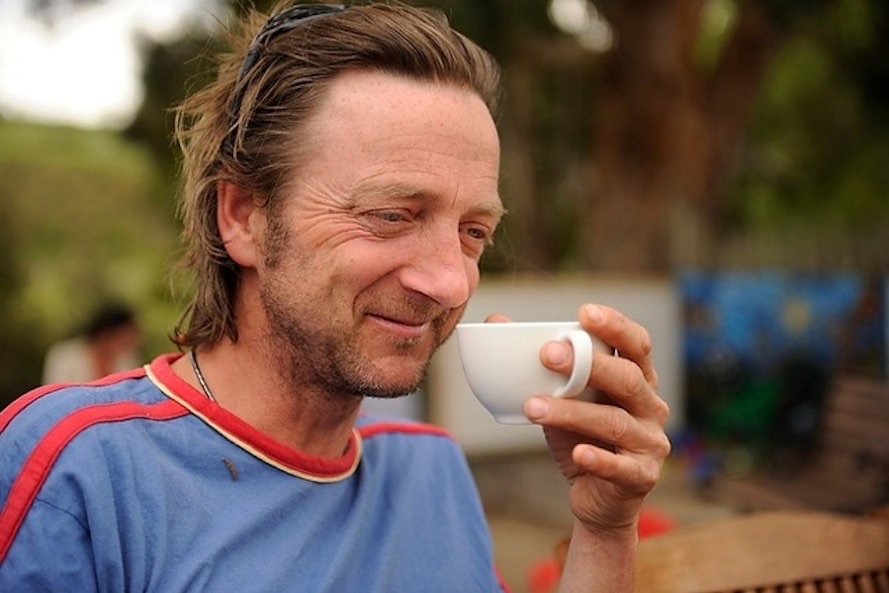Last year we interviewed Malcolm Bass about his alpine climbing and work as a Clinical Psychologist. It became one of our most popular articles, with Malcolm discussing his motivations, the highs and lows of both climbing and work, and his unique perspective on the minds of climbers. Malcolm has kindly given us his article, 'The Mind Has Mountains' which takes a deeper dive into this world. This article first appeared in the Alpine Journal in 2018.
'O the mind, mind has mountains; cliffs of fall Frightful, sheer, nomanfathomed. Hold them cheap May who ne’er hung there.' - Gerard Manley Hopkins
It had been a difficult day and I was tired. Part of me was hoping that my last patient, here for his first appointment, wouldn’t turn up. Lots of people don’t turn up for their first appointment, and the free slot would give me a chance to catch up on the day’s notes. But dead on the hour the receptionist rings to say that he is in the waiting room. I poke my head round the door, say his name, and a tall, slim man in dark chinos and open-necked shirt stands up.
I smile at him.
‘Hello, we’re just down here.’
He says nothing, but smiles back and I lead him down the short corridor to the consulting room. I go in first, hold the door open and he walks in.
‘Sit wherever you like.’
He chooses the chair near the door, and I sit in the one by the window. We both settle. I smile at him again.
‘So Mr Albright, what brings you here?’
He looks away from me up to the top corner of the window, pauses, then looks back at me and says: ‘I think I need some help with my climbing.’
It had been a difficult day and I was tired. Part of me was hoping that my last patient, here for his first appointment, wouldn’t turn up. Lots of people don’t turn up for their first appointment, and the free slot would give me a chance to catch up on the day’s notes. But dead on the hour the receptionist rings to say that he is in the waiting room. I poke my head round the door, say his name, and a tall, slim man in dark chinos and open-necked shirt stands up.
I smile at him.
‘Hello, we’re just down here.’
He says nothing, but smiles back and I lead him down the short corridor to the consulting room. I go in first, hold the door open and he walks in.
‘Sit wherever you like.’
He chooses the chair near the door, and I sit in the one by the window. We both settle. I smile at him again.
‘So Mr Albright, what brings you here?’
He looks away from me up to the top corner of the window, pauses, then looks back at me and says: ‘I think I need some help with my climbing.’
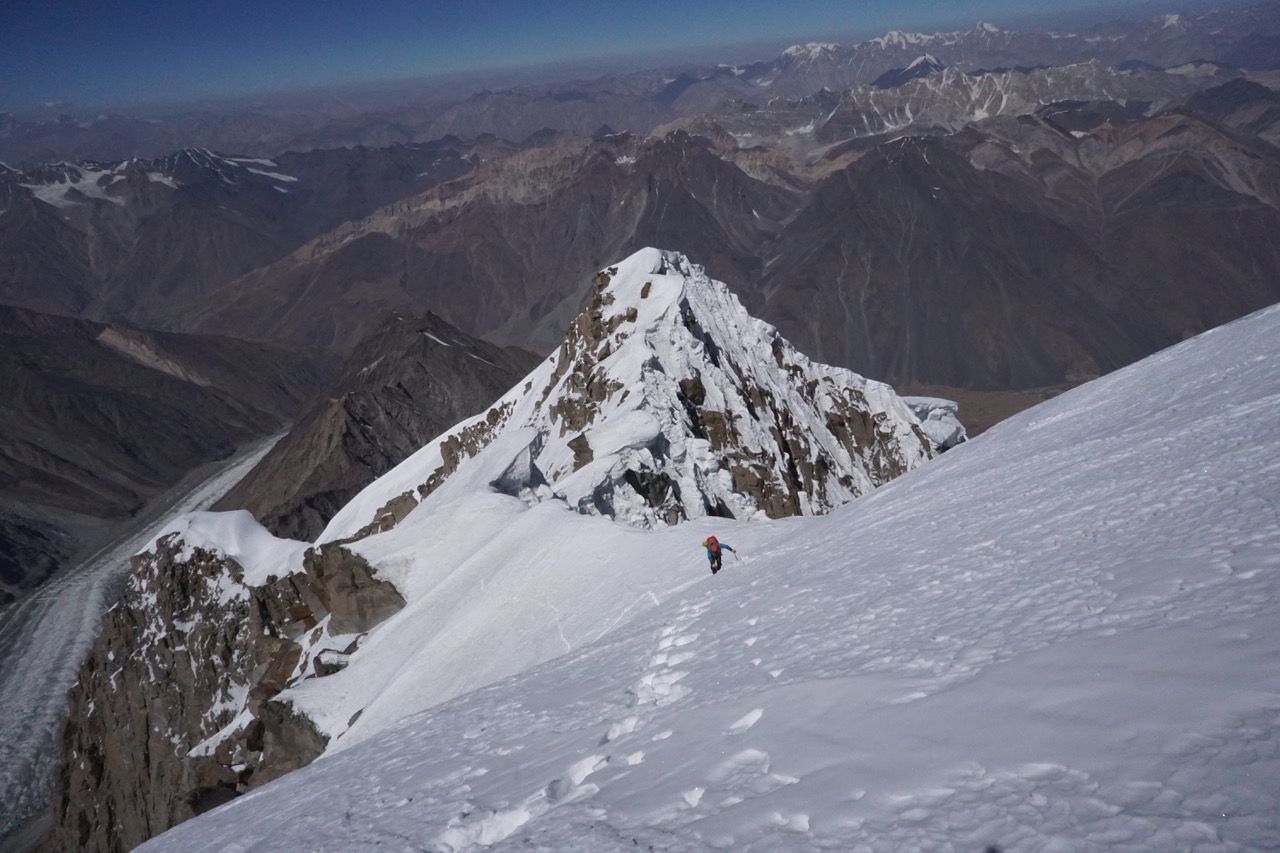
Ally Swinton approaches the summit on Day 5 of 'The Great Game,' Koyo Zom (6872m), Hindu Raj, Pakistan. Photo: Tom Livingstone
I qualified as a clinical psychologist in 1991 and found a permanent job in the NHS almost immediately. This was not due to any particular expertise on my part: trained psychologists were still a rare breed back then. By 1992 my financial position was secure enough, after years of poorly paid, short-term jobs taken en route to qualification, to go on my first Himalayan trip. Many more followed. I am still climbing in the Himalaya and I am still practising as a clinical psychologist.
After I submitted a particularly psychological trip report to the Alpine Journal, the editor gently suggested it might be better to write trip reports about climbing, and to corral the psychology into a dedicated article based on my overlapping experiences as a clinician and an alpinist. So I am going to attempt to describe how a clinical psychologist might think about alpine climbing.
I should start by defining those terms. ‘Clinical psychologist’ is a legally protected title and refers to practitioners who have completed a psychology degree and then a doctorate in clinical psychology, both at universities approved by the British Psychological Society. The majority of clinical psychologists (just ‘psychologists’ from here on) are employed in the NHS in mental health or disability services; others work in local authority social service departments, private healthcare, or are self-employed. The details of the work they do and the people they seek to help are determined largely by their employing organisation, but their broad purpose is to use the science and technology of psychology to understand and alleviate distress and promote mental wellbeing. The sort of alpine climbing I discuss here is that which involves pitches of technical climbing at altitude on big snowy mountains in glaciated regions.
Alpine climbing has a rich literature, as well as vigorous oral and visual storytelling traditions. Compared to these ways of thinking and communicating about alpinism, psychology is a relatively quiet newcomer to the scene, and I make no claim that it gives any greater depth of insight. But I hope I can show that a psychological approach to the subject offers an interesting perspective. And the psychological approach I will be using here is broadly positivist and materialist: crudely that there is an external world out there, and we can learn how it works through observation and experiment. This is in contrast with the post-modern idea that what we think of as reality is constructed in our minds from concepts our culture teaches us, and that unbiased observation is impossible, or even meaningless. Psychology needs both approaches: we are physical beings of flesh, blood, bone and fluids, each experiencing the world in a unique way that has only the most tentative connection with reality.
I am always brought up short when I show people who aren’t alpinists photographs of my potential beautiful new route. They don’t see it. They just see a mountain. Because in reality there are an infinite number of possible lines up a mountain and that is what non-climbers see when they look at the photograph. They don’t see the ‘magic line’ that leaps off the page at me: this only reveals itself to the fully indoctrinated alpinist. Our alpine-climbing culture has taught us what to see. Score one for the post-modernists. But when we are five days up that route, sleep deprived from sitting bivouacs, and we fully believe our judgment is as good as it was on day one, we will be wrong: our mental faculties will have declined in measurable ways (Killgore, 2010). That levels the score for the materialists.
Back to the punctual Mr Albright: how might I, as a clinical psychologist, begin to think about his request for some help with his climbing? I will start by referring to him here as ‘A’ in the classic Freudian tradition, although let me reassure you that Freud will now be restricted to cameo appearances.
It doesn’t take long to establish that A feels torn. None of his last three, long and costly trips to the Pakistan Karakoram have resulted in a summit. His most recent collapsed in a welter of interpersonal and financial disputes, which are still rumbling on months later. A large part of him just wants to give it all up but he senses that this won’t be easy. And, confusingly for him, another part of him wants to go the other way: to give up his job, train harder, plan better, aim higher and ‘give up this renaissance man, dilettante bullshit of doing a lot of different things (and none of them very well by real standards).’ (Twight, 2000). He either wants to stop, or to get better. Ambivalence is a universal human experience, and often very painful. Psychologists approach it using a simple technique known as motivational interviewing (Miller, 2013) in which the person is helped to explore all the pros and cons of continuing with, or stopping, certain behaviour. The psychologist doesn’t advise, instead they guide the discussion so that the person becomes aware of all the actual and potential consequences of each course of action, both wanted and unwanted. Commonly used with people struggling with drugs or alcohol, the approach encourages frankness about the joys they bring the person, as well as a lingering over the costs. A and I will need to talk about all the good things that alpinism brings him, but we will also need to talk about death.
I have a lot of communication with active alpinists. We often talk about attempts on new routes on peaks over 6,000m, but we very rarely talk about the risk of getting killed. And if we do it is usually by way of a joke. Yet the risk of getting killed is high, perhaps very high. One estimate of the lifetime risk for ‘elite’ alpinists of getting killed in the mountains puts it at just over 20%. The risk is less for women at 12% but not statistically significantly less, although there were far fewer women in the sample. (Weinbruch and Nordby, 2010). Liz Hawley’s records (Windsor et al, 2009) suggest that at least one in every hundred people going above base camp on peaks over 7,000m in Nepal will die there. (Peaks below 7,000m seem much less risky.) And of the 14 alpinists I met at the 2011 Piolet d’Or two have since been killed in the mountains (Bjorn Evind Årtun and Kyle Dempster) and one of the nominees I never met as he died in a crevasse fall before the event (Max Belleville).
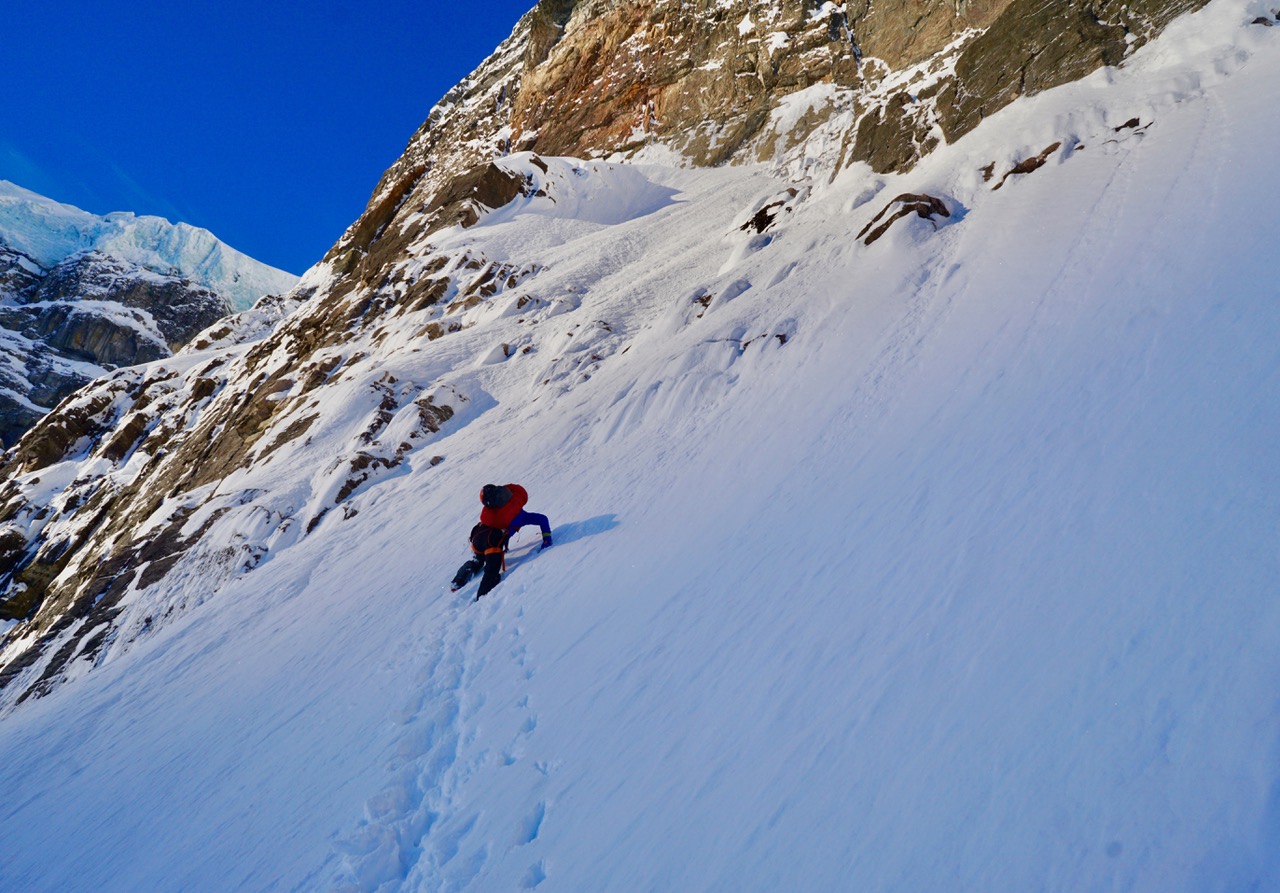
Fabi Buhl finds the light in the Canadian Rockies. Photo: Tom Livingstone
Is A aware of these figures? And have they really hit home? Perhaps, like his psychologist, he has created what he hopes is a valid argument why they don’t apply to him: he only climbs steep buttresses and ridges with minimal objective danger and he only goes to glaciated mountains once a year.
Maybe he’s right and those behaviours do reduce the risk. Or maybe his risk assessment is subject to one of the many biases that experimental psychology has shown to undermine the quality of our decision making (Lebowitz and Lee, 2015). The choice supportive bias, where we exaggerate the positive attributes of choices we have already selected, might be at play here.
And that tentative statement ‘might be at play here’ brings us to one of the big problems of psychology. Many of psychology’s findings are based on the study of large groups in an attempt to reveal universal principles that apply to all human beings. Yet this method smoothes out the differences between people. So while it is now clear from experiments there is a general tendency for most people to display a choice supportive bias, to overrate the positive attributes of choices they have already made, within that group there will be outliers, people who already hate the choice they’ve made. The general findings, useful as they are at the population level, may not apply to the person sitting in front of you now. People vary. Clinical psychologists attempt to solve this problem by drawing up an individual formulation with each person. Psychological findings pertinent to the issue at hand are advanced tentatively, as hypotheses, to see whether they chime with the person’s experience. If not, they are laid aside. But if they do ring true they become part of the formulation, part of the shared understanding of what is going on.
Psychology is often pilloried for that familiar offence of ‘stating the bleeding obvious’. One of Feldman’s Everest findings could be seen as a prime example: he and his colleagues found that people who experienced high anxiety levels on the mountain had less chance of reaching the summit than those who felt less anxious. So maybe A experiences intolerable levels of anxiety when high above the Batura glacier, and it is these that turn him back prematurely? But it turns out that A’s experience is rather the opposite; he feels a sense of calm, of being in his element, quite different to being at work. Hypothesis rejected, we need to do more work to formulate why he turns back, but another interesting door has opened.
The great variability of human beings, and the problems with trying to apply general findings to specific individuals, means that readers may find that some of the ideas in this article don’t resonate with their own experience. But they might be true for people that you climb with. It is easy to fall into the trap of assuming that others experience the world just as we do, or, conversely, to deny any commonality of experience: people are generally not very good at guessing what is going on in other people’s heads (Ickes, 2003). Our guesses are likely to reveal more about our own mental state than about the other person’s. So if you really want to know it’s best to ask (Epley et al, 2017). But only do so if you have the mental energy and will to respond to what you hear: sometimes it’s best not to know. When tired and pushing hard on a big climb I often don’t care where my partners’ heads are at as long as they appear vaguely functional.
The applicability problem is more pronounced for women. Unless researchers are trying to investigate something specific about the psychology of either men or women, current best practice is to have equal numbers of each gender in your study groups, and to report whether and how gender influenced the results. This is harder if you are studying alpinists because of the gender imbalance in the activity. The studies cited here range from those that have no women in the study group (e.g. Van Yperen, 2009), through those that have a good balance but don’t report on any differences (e.g. Woodman et al, 2009) to those that report on the gender differences they found (Weinbruch and Nordby, 2009). So it is less likely, but still quite possible that the concepts described here will ring true for women.
However, once again, we have neatly stepped away from thinking about death. Human beings seem to struggle to give ideas that provoke deep anxiety, like death, disease, infection and child abuse the right amount of attention. We seem either to worry about things excessively and fruitlessly, or to gloss over them. We struggle to hold them in mind effectively. This can be helpful, even protective; thinking about difficult things all the time is exhausting and ultimately disabling. Denial, blocking painful facts from awareness, is one of the classical defence mechanisms that Freud stated we use to protect our psyche (McLeod, 2009).
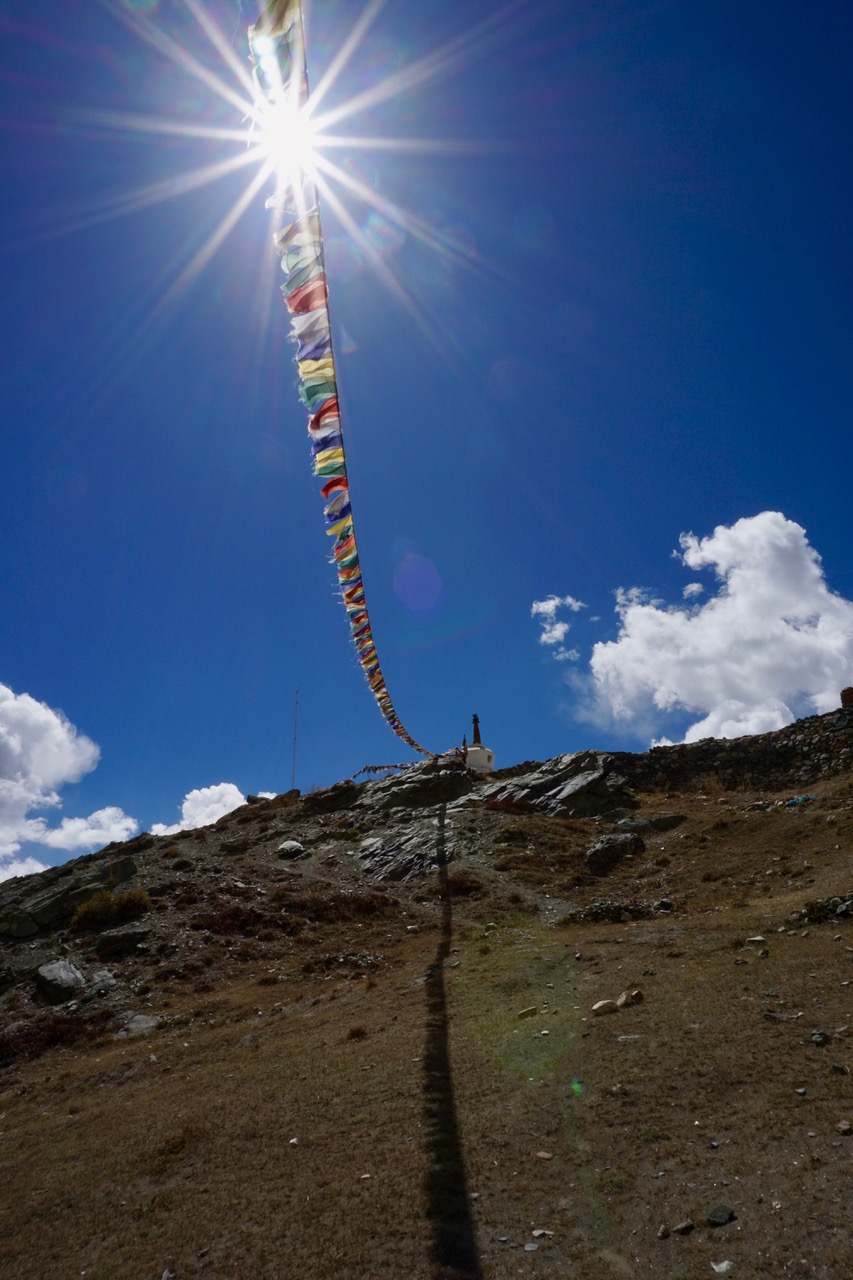
Prayer flags in the Zanskar region of India. Photo: Tom Livingstone
The culture of the group we belong to has an enormous influence on most of us. In modern western society most of us belong to multiple communities, each with their own distinct culture. Alpinism seems to me to be a strong culture. Its members are keen to identify as alpinists (or maybe alpine climbers or, more rarely now, mountaineers), and identifying as such influences our behaviour. We have all read many of the same books and admire many of the same historical figures. We cherish alpine style, don’t know how to prusik properly and like Scotland. And maybe we unconsciously glorify death in the mountains. I can’t provide any hard evidence for this claim; I sense it more than see it. I sense it in our rush to talk about recent climbing deaths, in the words of some obituaries, in our celebration of lethal climbs, and in our veneration of the dead. This is maybe because I have been particularly sensitised to the issue: from ages seven to 12 I went to a private boarding school, a preparatory school for the famous public schools, and there absorbed the idea that if you’d missed your chance to die gloriously being torn apart by machine gun bullets as you led your men over the top, then expiring near either pole, up a mountain or at sea was a reasonable substitute. I escaped that system at 12 and went on to a school run by the strictly pacifist Society of Friends: the Quakers. I was taught to hear the call to glory and then given the tools to question it.
Back to the clinic: A is not in denial about the risks. One of the reasons he is thinking about quitting is that each climb is another roll of the dice. He doesn’t need motivational interviewing to become aware of the risk of death, nor of the impact that would have on those close to him. He is cleareyed too about the things that he loses by climbing as he does. It takes a lot of time and attention to plan, and execute these big trips; time that he could spend with the people that he loves, or working on something useful.
Some of the other drawbacks are a bit harder to pin down. A tells me how, when he is actually on an expedition, he is sometimes ambushed by powerful negative feelings about the whole enterprise that seem to leap out of nowhere: terror of getting killed; crushing guilt about the risks he is taking with the future happiness of the people who love him; boredom and a sense of futility. Granted that altitude sickness, gut problems, bad weather, a virus or some awful combination of all these is often the harbinger of these miserable states of mind, but A wonders why they are both surprising and, at the same time, very familiar.
A Freudian would point to another defence mechanism, repression, sometimes known as motivated forgetting, which explains it well enough: A has had exactly the same feelings on previous trips and then forgotten all about them. There is also a huge experimental literature that shows how people are not very good at predicting how they will feel in any given future situation, or at remembering how they felt last time they were in that situation. We tend to overestimate how happy events will make us feel and for how long. And we remember previous mood states most accurately when we are once again in that same mood state: the vicious downward spiral in depression. If A wants to get an accurate picture of how he really feels on expeditions he will need to keep a journal and read it when he is thinking about his next trip. And despite his doubts, part of him has already started thinking about his next big trip. Why?
We have finally arrived at the ‘why’ question. We were always going to end up here but even so, it is with some trepidation that I begin.
The human mind seems prone to a couple of tendencies when thinking about causation. First we have a preference for single-factor answers: the apple falls because of gravity. And second we like to set up rival plausible hypotheses in competition with one another: is the increase in adolescent mental health problems caused by social media or the fear of not being able to find a job and buy a house? But human behaviour is influenced by an almost infinite array of factors, each of which, on their own, seem to make a disappointingly small contribution from a psychologist’s point of view.
As Niall Grimes begins a conversation with Steve McClure for his Jam Crack podcast he half jokes that his task is to find out ‘what is your major malfunction numb nuts?’ (It’s a quote from the Stanley Kubrick film Full Metal Jacket.) This quest, to find the unresolved childhood hurt that drives the hero, has its roots in psychoanalytic theory, and has become so influential and widely practiced in biography, especially concerning alpinists, that we scarcely notice its presence. We feel satisfied when the account is properly resolved, when we understand what exactly is wrong with the star. There might be something in this: for instance Van Yperen in 2009 found that parental divorce rates were much higher in those adolescents who went on to make a professional career in soccer than those who didn’t. But we need to be cautious about it becoming the only sort of answer we are looking for. The influential positive psychology movement has encouraged us to look just as hard for the positive characteristics, strengths and habits of successful, happy and fulfilled people (Carr, 2003).
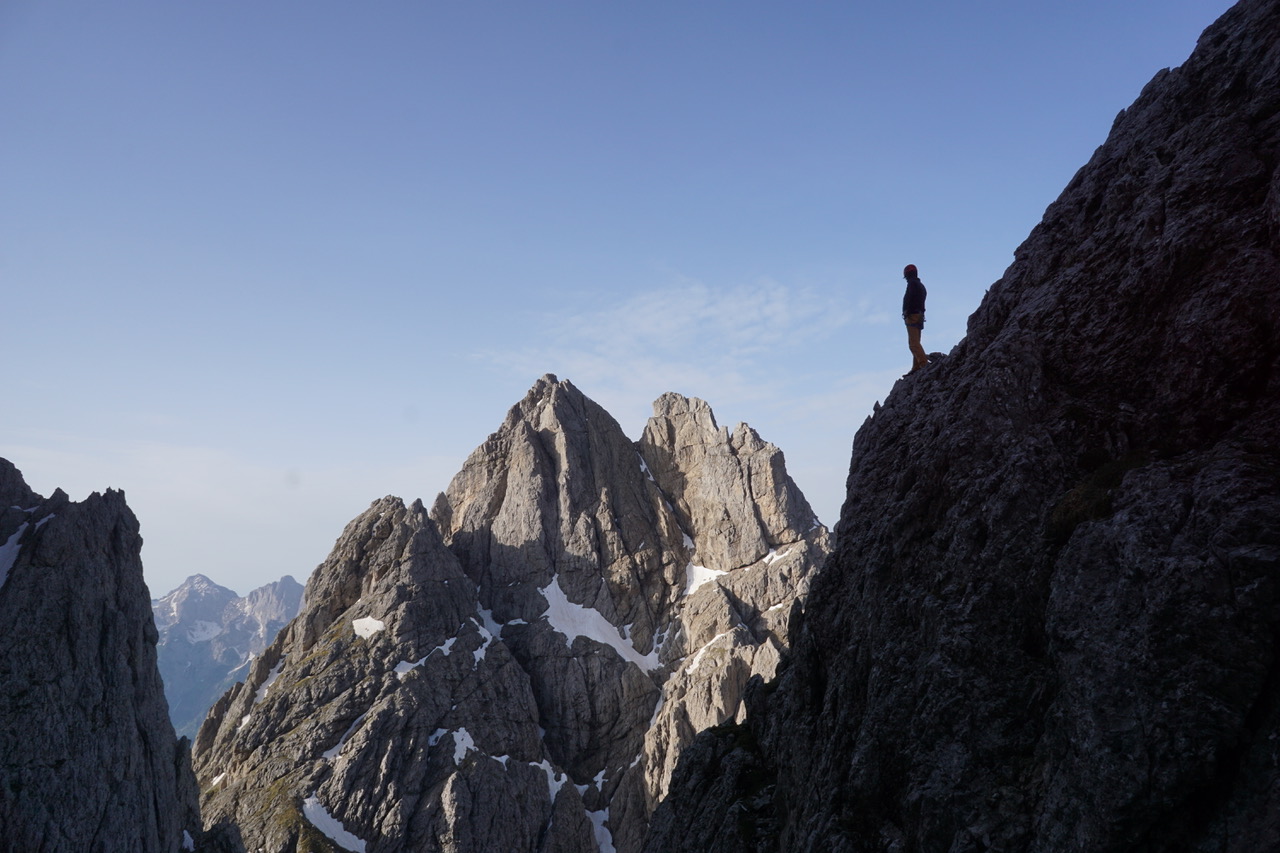
Žiga Oražem finds the way in the Pala di San Martino region of the Italian Dolomites. Photo: Tom Livingstone
We know that any behaviour (and for all its complexity and culture, many psychologists would think of alpine climbing as a behaviour) that persists over time will be maintained by a wide variety of factors, will offer many rewards. In the jargon the behaviour will be maintained by many functions. This is what leads to its persistence. The reason the ‘why’ question is so engaging and so hard to answer, is that alpine climbing offers so many rewards. I find it helpful to resist the temptation to ask ‘yes, but what is the real reason?’ I ask instead ‘what are the important rewards for this person (maybe ourselves) at this time?’ And this is what I would do with A, because whether he ultimately decides to keep climbing, or to stop, understanding what he gets from it will be helpful. If he decides to stop it will help him in planning a different lifestyle, one that meets these needs in other ways; and if he goes on it will help him focus on attaining what matters to him.
We would start back at the beginning, with his early days on rock or in the hills. Long-lived behaviours typically shift function over time and what motivated our first steps may not be what we are after today. The archetypes of this are the Himalayan superstars who find freedom, camaraderie and beauty in the mountains in their youth, only to end up competing with one another for fame to the point of death.
In a very readable article Jim Lester (2004) described his findings from reviewing a great swathe of climbing literature in search of ‘passionate climbers’ describing the meaning they found in the activity. He categorised the main themes thus:
A sense of freedom
A sense of power, energy and vitality
Contact with a better self
Assertion of self
Conquest of self
Escape from self
Contact with a higher power
Unity
These are mostly self-explanatory, but it may help to add that Lester’s ‘contact with a higher power’ includes both religious experiences and also new-age contact-with-the-universe or dissolution-of-self type experiences. (As you can maybe tell, I don’t get either.) Unity is a sense of wholeness or integration: ‘I feel completely and wholly myself’.
Lester’s list provide a useful set of prompts for A and I as we explore the functions of alpinism in his life. And as we think about whether he experiences any sense of asserting himself, I am reminded of something A said earlier in our conversation, that he felt calm and in his element when on the mountain. He is not alone in this.
In the most sophisticated series of empirical studies on the psychology of mountaineering to be published to date, Tim Woodman and colleagues from Bangor University (Barlow et al, 2013) may have identified two related specific motivations for very many mountaineers (to use their term). These are the desires to experience emotion regulation and agency. Emotion regulation is the ability to ‘influence which emotions we have, when we have them, and how we experience and express them’ (Gross, 2002) and agency is the sense that we can influence what happens in our lives. These motivations are specific in that they are more present in mountaineers than in other high-risk sports people (sky divers, extreme skiers and rock climbers) and ‘normal’ controls. Mountaineers appear to have a stronger desire to experience emotion regulation and agency than other people, possibly because they don’t feel they have them in day-to-day life. And, these studies suggest, mountaineering delivers the experience of emotion regulation and agency that its adherents are looking for, and that these effects persist and go with the climber back into their day-to-day life. The theory just about manages to avoid the ‘damaged alpinist’ trope by suggesting that mountaineers have a relatively high expectation of achieving effective emotion regulation in their day-to-day lives, not that we are poor at emotion regulation.
This idea certainly strikes a chord with A. Although he is doing pretty well in the ‘real world’ – he is in a loving relationship, is doing well enough at work – he lives with a constant buzz of low-level anxiety. Sometimes this seems to be about money, sometimes about his health, sometimes about his family; nothing is ever really very clear, he’s never quite sure what he should be doing next: it’s worrying and exhausting. On the hill things are much clearer. He is frightened of things that might kill him, and he can act to avoid them. He feels the urge to stop, to just sit down and rest when breaking trail up the snow field, but he knows how to push on through. Things are both simpler and harder, he knows what has to be done, and often he knows how to do it.
But as A and I discuss the pros and cons of him committing to another few years at the sharp end we both notice something missing from both Lester’s list and the agent plus emotion regulation account: other people. This doesn’t mean that these ideas aren’t valid, they just represent a different level of analysis, the intrapersonal (within the person) rather than the interpersonal.
Now we’re going to leave A and my clinical psychologist self as we sit in the consulting room discussing how his climbing friends, because he really only has climbing friends, and the memories, plans, and rituals they share bind him to the activity. I don’t know what he will decide, and perhaps it doesn’t really matter: if we rule out more extreme events such as life-changing injuries or illness, major trauma, or migration, we find that for most of us our happiness levels remain about the same whatever we do: the ‘happiness set point’, explained in Carr, 2003. If he decides to carry on with his Karakoram adventures, and if he decides that summits matter, then he has some work to do to find out what, if anything, is holding him back. He might just have been unlucky so far: the stars do need to align to let us get up these sorts of routes. If so, the persistence he has shown so far will serve him well. But perhaps it’s something else? Maybe he aims too high? Or climbs with the wrong people? Or turns round too early? Whatever it is I hope maybe that a concept from psychology, more likely sports psychology than the clinical sort, will help him to the summit and safely home again.
A sense of power, energy and vitality
Contact with a better self
Assertion of self
Conquest of self
Escape from self
Contact with a higher power
Unity
These are mostly self-explanatory, but it may help to add that Lester’s ‘contact with a higher power’ includes both religious experiences and also new-age contact-with-the-universe or dissolution-of-self type experiences. (As you can maybe tell, I don’t get either.) Unity is a sense of wholeness or integration: ‘I feel completely and wholly myself’.
Lester’s list provide a useful set of prompts for A and I as we explore the functions of alpinism in his life. And as we think about whether he experiences any sense of asserting himself, I am reminded of something A said earlier in our conversation, that he felt calm and in his element when on the mountain. He is not alone in this.
In the most sophisticated series of empirical studies on the psychology of mountaineering to be published to date, Tim Woodman and colleagues from Bangor University (Barlow et al, 2013) may have identified two related specific motivations for very many mountaineers (to use their term). These are the desires to experience emotion regulation and agency. Emotion regulation is the ability to ‘influence which emotions we have, when we have them, and how we experience and express them’ (Gross, 2002) and agency is the sense that we can influence what happens in our lives. These motivations are specific in that they are more present in mountaineers than in other high-risk sports people (sky divers, extreme skiers and rock climbers) and ‘normal’ controls. Mountaineers appear to have a stronger desire to experience emotion regulation and agency than other people, possibly because they don’t feel they have them in day-to-day life. And, these studies suggest, mountaineering delivers the experience of emotion regulation and agency that its adherents are looking for, and that these effects persist and go with the climber back into their day-to-day life. The theory just about manages to avoid the ‘damaged alpinist’ trope by suggesting that mountaineers have a relatively high expectation of achieving effective emotion regulation in their day-to-day lives, not that we are poor at emotion regulation.
This idea certainly strikes a chord with A. Although he is doing pretty well in the ‘real world’ – he is in a loving relationship, is doing well enough at work – he lives with a constant buzz of low-level anxiety. Sometimes this seems to be about money, sometimes about his health, sometimes about his family; nothing is ever really very clear, he’s never quite sure what he should be doing next: it’s worrying and exhausting. On the hill things are much clearer. He is frightened of things that might kill him, and he can act to avoid them. He feels the urge to stop, to just sit down and rest when breaking trail up the snow field, but he knows how to push on through. Things are both simpler and harder, he knows what has to be done, and often he knows how to do it.
But as A and I discuss the pros and cons of him committing to another few years at the sharp end we both notice something missing from both Lester’s list and the agent plus emotion regulation account: other people. This doesn’t mean that these ideas aren’t valid, they just represent a different level of analysis, the intrapersonal (within the person) rather than the interpersonal.
Now we’re going to leave A and my clinical psychologist self as we sit in the consulting room discussing how his climbing friends, because he really only has climbing friends, and the memories, plans, and rituals they share bind him to the activity. I don’t know what he will decide, and perhaps it doesn’t really matter: if we rule out more extreme events such as life-changing injuries or illness, major trauma, or migration, we find that for most of us our happiness levels remain about the same whatever we do: the ‘happiness set point’, explained in Carr, 2003. If he decides to carry on with his Karakoram adventures, and if he decides that summits matter, then he has some work to do to find out what, if anything, is holding him back. He might just have been unlucky so far: the stars do need to align to let us get up these sorts of routes. If so, the persistence he has shown so far will serve him well. But perhaps it’s something else? Maybe he aims too high? Or climbs with the wrong people? Or turns round too early? Whatever it is I hope maybe that a concept from psychology, more likely sports psychology than the clinical sort, will help him to the summit and safely home again.
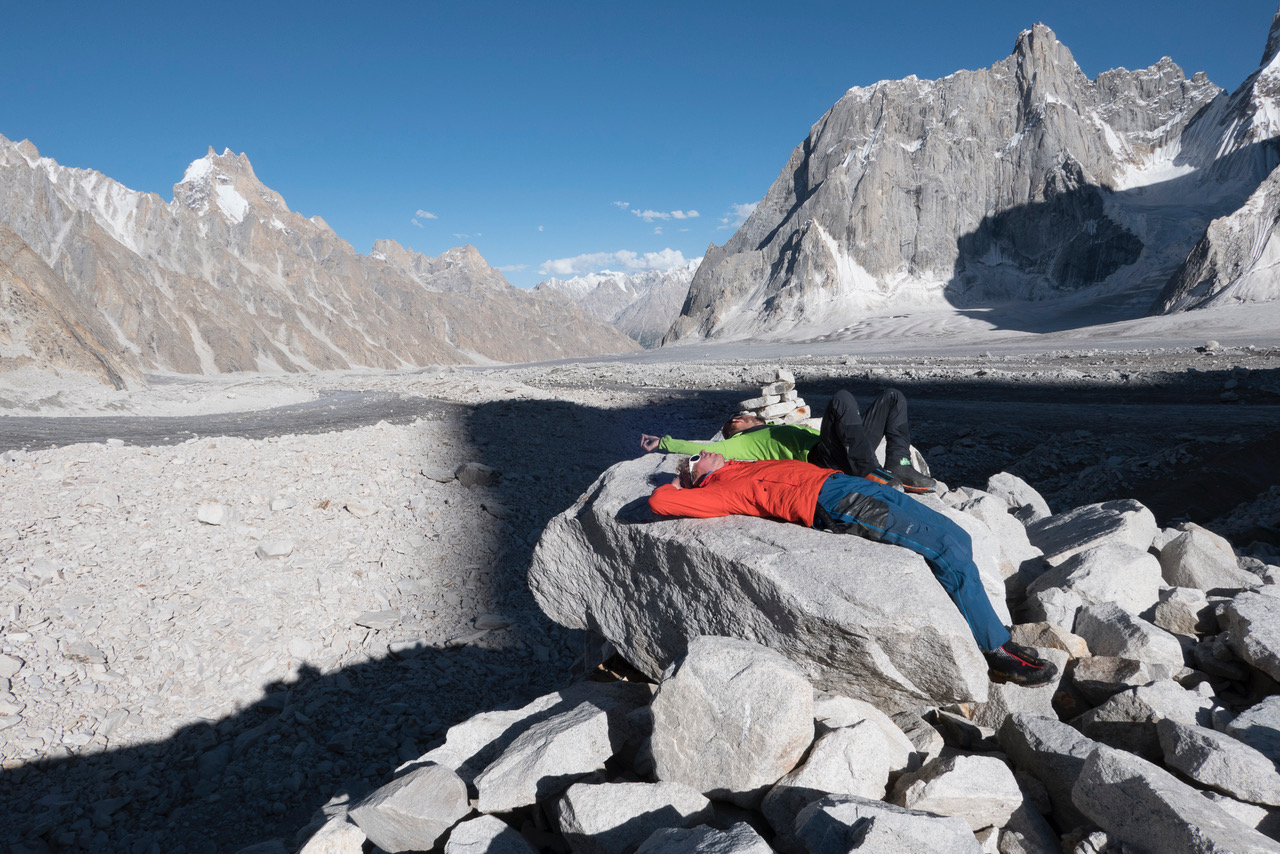
Content. Tom Livingstone and Luka Stražar back at base camp after climbing Latok 1 (7145m). Photo: Aleš Česen
And now, to finish, I’m going to say a bit of what I know of my own psychology. In the course of my work I have been subject to multiple personality assessments. Psychologists define personality as the relatively enduring aspects of the way a person thinks, feels and behaves, those features of a person that are apparent across a wide range of situations. The personalities of climbers and mountaineers have been much studied (e.g. Gray, 1968, in this journal). This is at least partly because it is an easy thing to study; ask each participant to fill in a questionnaire and the research is done. I have found it hard to draw any conclusions from this literature, partly because the researchers have used so many different classification systems, and maybe because there isn’t a standard alpinist personality type.
In an attempt to get round the problems caused by multiple classification systems many personality researchers are rallying round a system called ‘The Big Five’. The Big Five have been derived mathematically rather than conceptually: factor analysis has been used to look at the responses to thousands of personality assessments of many different types, and the answers have found to coalesce into five broad clusters. These are: conscientiousness, agreeableness, neuroticism, openness to experience and extraversion. CANOE is the mnemonic. It’s also referred to as OCEAN.
Through my work I have been assessed numerous times, and find that my personality is pretty average on extraversion and agreeableness, but high on openness to experience, conscientiousness, and neuroticism. Openness to experience is about curiosity, exploration, the search for new experiences, and the drive to learn new things. It was that trait, reinforced by a family and school culture that valued adventure, which first drew me to the outdoors. If I saw a picture of someone climbing a mountain I wanted to try that. When I looked at my dad’s caving photographs I wanted to go underground. At first I pretended to have adventures, and then I started to have real ones. And it still underpins a lot of my motivation; if I see a picture of a half decent mountain in a part of the world I haven’t been to my pulse quickens and I just want to go there. Hatching a plan with a friend to go there is even better, especially if the trip is some time away and the trip shimmers in a much discussed shared future.
Let’s get that neuroticism out of the way; it is the tendency to feel negative emotion, to feel anxious, to worry, to get frustrated and angry, to take things to heart. It is being the opposite of being a calm, phlegmatic person. This could be my major malfunction. It is certainly true that I live on a bit of an emotional roller coaster. Fear (of dying) and guilt (about leaving and maybe dying) undermined several of my early attempts in the Himalaya and Karakoram. But on the other hand anger helped me up my hardest climb, the west face of Vasuki Parbat (6780m) in the Indian Garwhal Himalaya with Paul Figg in 2010. In the run up to this trip I had been treated unfairly at work by a more senior psychiatric colleague in ways that had cost me money and status. I felt the righteous fury of the wronged and silenced.
I reverted to adolescence and trained manically to a soundtrack of raucous, worryingly self-destructive punk. I was really going to show them. Sports psychology research suggests that John Lydon (previously Johnny Rotten) was right: anger is an energy (Woodman et al, 2009 ) and it drove me up that face. But sadly I don’t think many of those psychiatrists saw the trip report on UKClimbing.com or read the Alpine Journal.
I don’t like climbing like that now. It has a slightly out of control feeling, and it leads to mistakes, several of which we made but got away with. I am more comfortable with fear now too, partly through familiarity, and partly through a deliberate effort, mostly through mindful meditation, to reduce my emotional reactivity across all aspects of my life, the conscientious side of my nature being useful for holding me to such long-term programmes. My neuroticism should make me an ideal candidate to benefit from the experience of more effective emotion regulation on the hill. But sadly, because I am a fan of Woodman and colleagues’ elegant programme of research, I find that my ability to regulate my emotions is about the same on a mountain as it is at work. So what do I get from alpine climbing?
I like Lester’s list, but for me it misses out both the natural world, and the social element of alpine climbing. Spending time in nature, in woods, near streams, by the sea, and yes, sometimes on mountains (but only some mountains) is a great source of joy to me. On Scottish hills I tend to feel a pretty reliable mixture of happiness and awe. I feel that I belong in the landscape, warm towards it, and to some extent embraced by it. It’s totally different in foreign, glaciated mountains: here I sometimes feel repugnance or disgust towards the mountains, sometimes a shiver of fear. I get the urge to zip up the tent and shut them out. What they seem to offer me is challenge: something strengthening, but not in the least consoling. There is a lot for me to think about here, and it is a rich area too for research psychologists who are just getting to grips with how our relationship with nature, and our physical activities within it, effect our emotional state (e.g. Lawton et al, 2017).
One last psychological theory now to bring in the social element of alpinism: Ryan and Decci’s self-determination theory (2000). This is an ambitious project: an attempt to describe, in a parsimonious way, core human psychological needs. Their theory suggests three such needs: competence, relatedness, and autonomy. How well then does alpine climbing meet all core human needs? Pretty well in my case, which is probably why I am still doing it. I feel very free when I am in the mountains. Free from duties and responsibilities that I don’t value, free from rules I don’t respect, free to move around, and free to be myself: I feel a sense of autonomy, a sense of freedom, and some of what Lester calls unity.
I think that competence has now become my major driver. I feel a great sense of personal pride in having acquired the skills to plan and execute trips to climb new routes on big mountains: it seems to have taken me a very long time. But as much as I enjoy using the skills I have learnt, it is the real prospect of doing things better next time that I find so compelling. Expeditionary climbing is a complex process, and the Himalaya is a complex environment: there is a vast amount to learn about both. I am writing this just a month after coming back from climbing Janhukot (6810m) in India with Paul Figg and Guy Buckingham, and the list of improvements that I want to make on my next trip is growing fast. And it’s not just my own sense of competence that appeals, I am aware that I enjoy being seen by others as competent in this sort of climbing. It offsets to some extent how I appear at Kilnsey.
Feeling part of a small national and international community of alpinists involved in the same sort of endeavour matters to me too, and that sense of belonging, of being known, takes us into the outer edges of Ryan and Decci’s concept of relatedness, the need to be close to other people. This style of climbing favours small, self-contained expeditions, typically five or six people at a remote base camp and even smaller climbing teams; there are only ever two or three of us on the mountain. We climbers will know each very well from years of travelling and climbing together in these environments. And we will be together, working towards a challenging mutual goal, in relative isolation, for a matter of weeks: classical conditions for the development of a strong team spirit, which I find enormously rewarding to share. That it is rewarding to be part of a small, trusted group working together to learn how to live in and explore a challenging, novel environment: I wonder if an evolutionary psychologist would have anything to say about that?
Follow Malcolm on Instagram. Malcolm is sponsored by Montane, La Sportiva and Petzl
References
M Barlow, T Woodman, T Hardy, ‘Great Expectations: Different High-Risk Activities Satisfy Different Motives’, Journal of Personality and Social Psycho logy, 2013, 105(3), pp458-75.
E Barrett & P Martin, Extreme: Why Some People Thrive at the Limits, Oxford University Press, 2014.
A Carr, Positive Psychology: The Science of Happiness and Human Strengths, Hove, Brunner-Routledge, 2003.
P Elbert & S Robertson, ‘A Plea for Risk’, Royal Institute of Philosophy Sup plements, 2013, 73, pp45-64.
T Epley, N Eyal & M Steffel, ‘Perspective Mistaking: Accurately Understanding the Mind of Another Requires Getting Perspective, Not Taking Perspective’, Journal of Personality and Social Psychology, 2017, 114:4, pp547–571.
G Feldman, C Zayfert, L Sandoval, E Dunn & J Cartreine, ‘Reward Responsiveness and Anxiety Predict Performance of Mount Everest Climbers’, Journal of Research in Personality, 2013, 47, pp111-15.
D Gray, ‘Personality and Climbing’, Alpine Journal 1968, pp167-172.
J Gross, ‘Emotion Regulation: Affective, Cognitive, and Social Consequences’, Psychophysiology, 2002, 39, pp281–91.
W Ickes, Everyday Mind Reading: Understanding What People Think and Feel, New York, Prometheus Books, 2003.
J Kerr & S Mackenzie (2012) ‘Multiple Motives for Participating in Adventure Sports’, Psychology of Sport and Exerise, 2012, 13(5), pp649-57.
W Killgore, ‘Effects of Sleep Deprivation on Cognition’, Progress in Brain Research 2010, 185, pp105-29.
E Lawton, E Brymer, P Clough, & A Denovan, ‘The Relationship Between Physical Activity Environment, Nature Relatedness, Anxiety, and Psychological Well-being Benefits of Regular Exercisers’ Frontiers in Psychology, 2017, 8.
S Lebowitz & S Lee, ‘20 Cognitive Biases that Screw up your Decisions’, Business Insider UK, (retrieved online from http://uk.businessinsider.com), 2015.
J Lester, ‘Spirit, Identity, and Self in Mountaineering’, Journal of Humanistic Psychology, 2004, 44, p86.
W Miller & S Rollnick, Motivational Interviewing: Preparing People to Change, Guildford Press, 2002.
S McLeod, ‘Defense Mechanisms’, www.simplypsychology.org, 2009.
R Ryan & E Deci, ‘Self Determination Theory and the Facilitation of Intrinsic Motivation, Social Development, and Well-being’, American Psy chologist, 2000, 55:1, pp68-78.
M Twight, ‘Twitching with Twight’, Kiss or Kill, Seattle, The Mountaineers Books, 2001.
N Van Yperen, ‘Why Some Make It and Others Do Not: Identifying Psychological Factors That Predict Career Success in Professional Adult Soccer’, Sport Psychologist, 2009, 23.
S Weinbruch & K-C Nordby, ‘Fatal Accidents among Elite Mountaineers: A Historical Perspective from the European Alps’, High Altitude Medicine and Biology, 2010, 11 (2), pp147-51.
J Windsor P Firth, M Grocott, G Rodway & H Montgomery, ‘Mountain Mortality: A Review of Deaths that Occur During Recreational Activities in the Mountains’, Postgrad Medical Journal, 2009, 85, pp316-21.
T Woodman, P Davis, L Hardy, N Callow, I Glasscock, & J Yuill-Proctor, ‘Emotions and Sport Performance: An Exploration of Happiness, Hope, and Anger’, Journal of Sports and Exercise Psychology, 2009, 31, pp169-88.
References
M Barlow, T Woodman, T Hardy, ‘Great Expectations: Different High-Risk Activities Satisfy Different Motives’, Journal of Personality and Social Psycho logy, 2013, 105(3), pp458-75.
E Barrett & P Martin, Extreme: Why Some People Thrive at the Limits, Oxford University Press, 2014.
A Carr, Positive Psychology: The Science of Happiness and Human Strengths, Hove, Brunner-Routledge, 2003.
P Elbert & S Robertson, ‘A Plea for Risk’, Royal Institute of Philosophy Sup plements, 2013, 73, pp45-64.
T Epley, N Eyal & M Steffel, ‘Perspective Mistaking: Accurately Understanding the Mind of Another Requires Getting Perspective, Not Taking Perspective’, Journal of Personality and Social Psychology, 2017, 114:4, pp547–571.
G Feldman, C Zayfert, L Sandoval, E Dunn & J Cartreine, ‘Reward Responsiveness and Anxiety Predict Performance of Mount Everest Climbers’, Journal of Research in Personality, 2013, 47, pp111-15.
D Gray, ‘Personality and Climbing’, Alpine Journal 1968, pp167-172.
J Gross, ‘Emotion Regulation: Affective, Cognitive, and Social Consequences’, Psychophysiology, 2002, 39, pp281–91.
W Ickes, Everyday Mind Reading: Understanding What People Think and Feel, New York, Prometheus Books, 2003.
J Kerr & S Mackenzie (2012) ‘Multiple Motives for Participating in Adventure Sports’, Psychology of Sport and Exerise, 2012, 13(5), pp649-57.
W Killgore, ‘Effects of Sleep Deprivation on Cognition’, Progress in Brain Research 2010, 185, pp105-29.
E Lawton, E Brymer, P Clough, & A Denovan, ‘The Relationship Between Physical Activity Environment, Nature Relatedness, Anxiety, and Psychological Well-being Benefits of Regular Exercisers’ Frontiers in Psychology, 2017, 8.
S Lebowitz & S Lee, ‘20 Cognitive Biases that Screw up your Decisions’, Business Insider UK, (retrieved online from http://uk.businessinsider.com), 2015.
J Lester, ‘Spirit, Identity, and Self in Mountaineering’, Journal of Humanistic Psychology, 2004, 44, p86.
W Miller & S Rollnick, Motivational Interviewing: Preparing People to Change, Guildford Press, 2002.
S McLeod, ‘Defense Mechanisms’, www.simplypsychology.org, 2009.
R Ryan & E Deci, ‘Self Determination Theory and the Facilitation of Intrinsic Motivation, Social Development, and Well-being’, American Psy chologist, 2000, 55:1, pp68-78.
M Twight, ‘Twitching with Twight’, Kiss or Kill, Seattle, The Mountaineers Books, 2001.
N Van Yperen, ‘Why Some Make It and Others Do Not: Identifying Psychological Factors That Predict Career Success in Professional Adult Soccer’, Sport Psychologist, 2009, 23.
S Weinbruch & K-C Nordby, ‘Fatal Accidents among Elite Mountaineers: A Historical Perspective from the European Alps’, High Altitude Medicine and Biology, 2010, 11 (2), pp147-51.
J Windsor P Firth, M Grocott, G Rodway & H Montgomery, ‘Mountain Mortality: A Review of Deaths that Occur During Recreational Activities in the Mountains’, Postgrad Medical Journal, 2009, 85, pp316-21.
T Woodman, P Davis, L Hardy, N Callow, I Glasscock, & J Yuill-Proctor, ‘Emotions and Sport Performance: An Exploration of Happiness, Hope, and Anger’, Journal of Sports and Exercise Psychology, 2009, 31, pp169-88.

